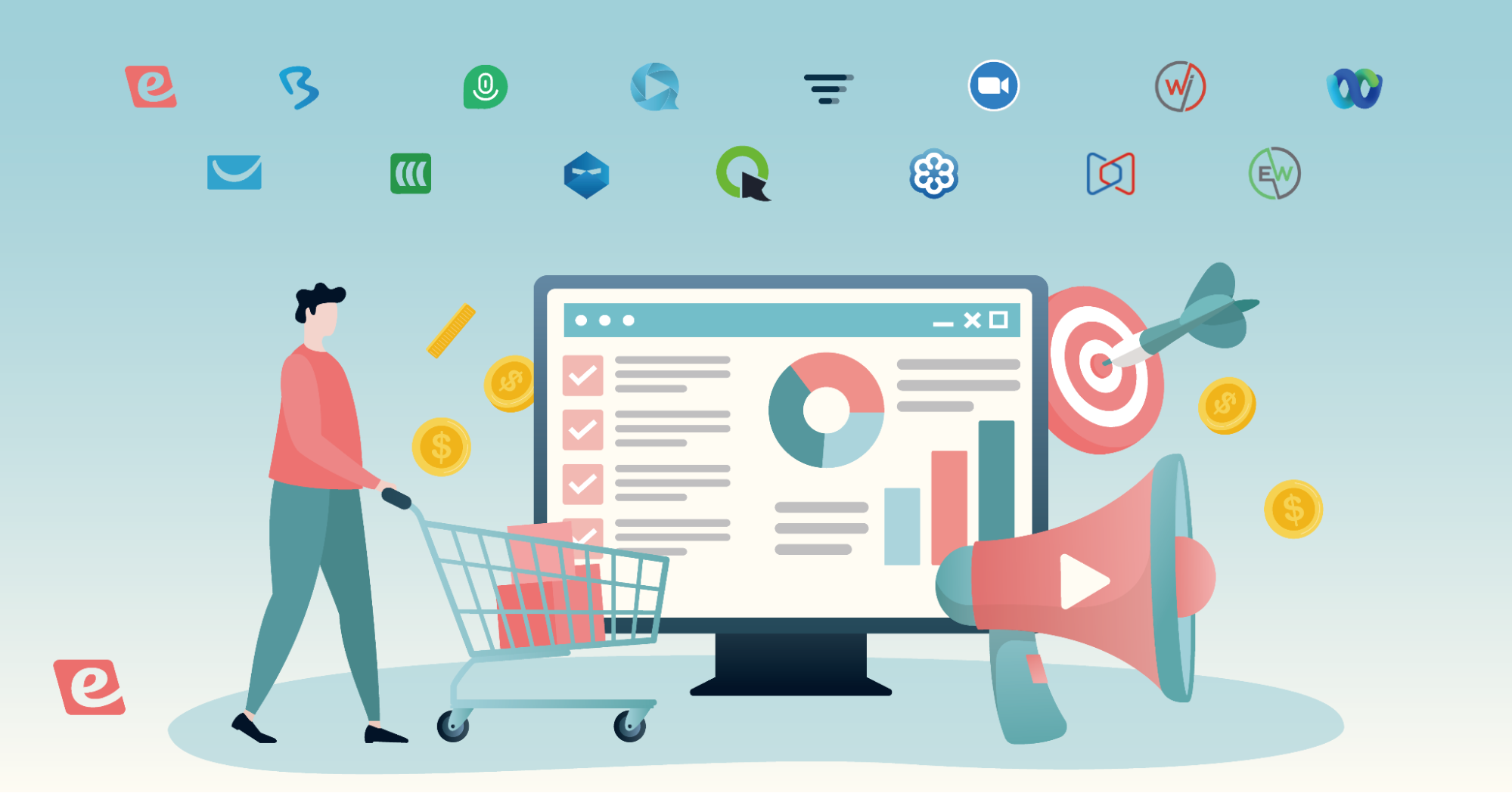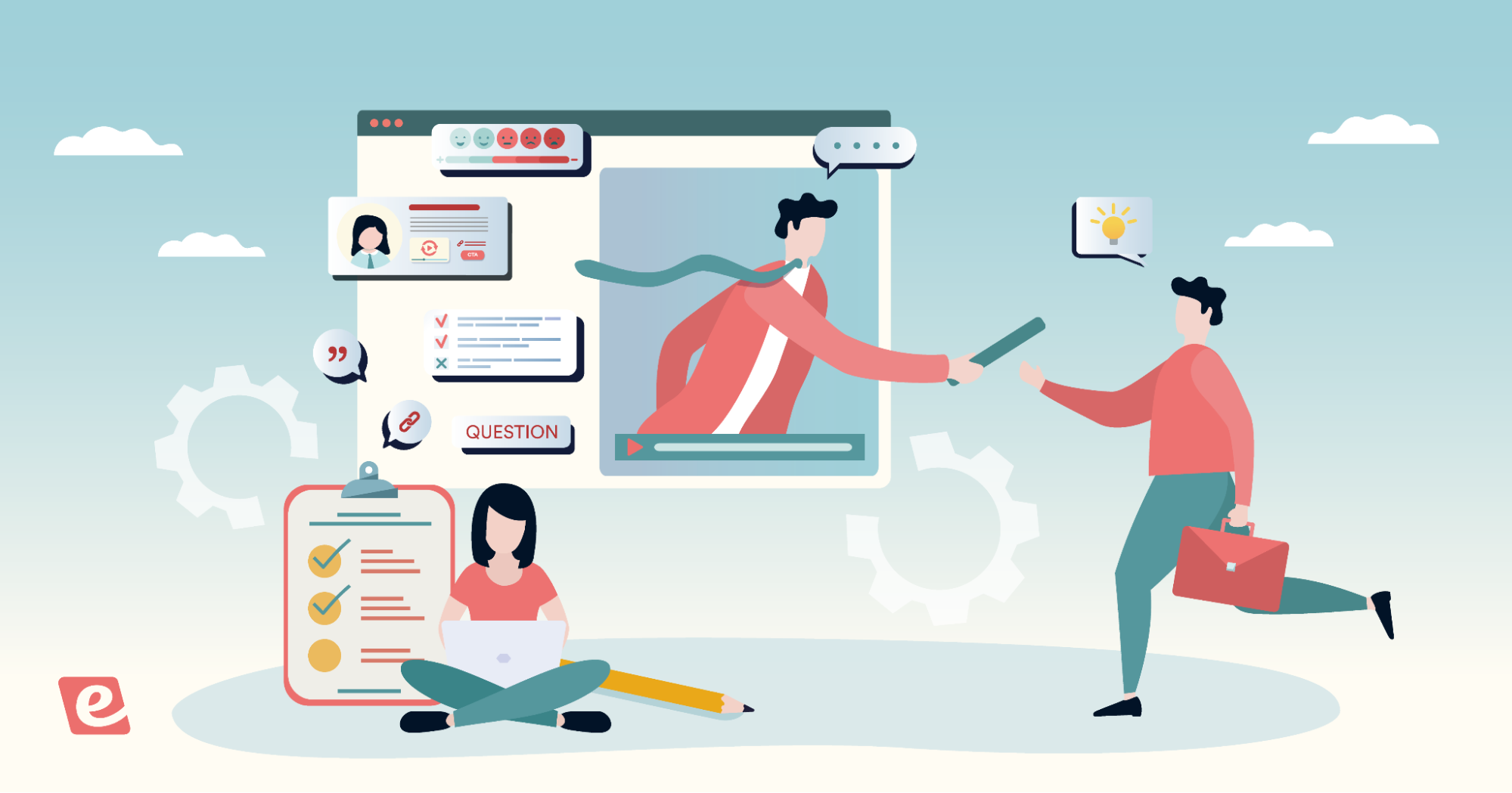Creating a webinar outline is the first step of many when it comes to planning webinars. To walk you through the process and make the endeavor feel less intimidating, this guide will go over how to create a webinar outline along with the best practices for doing so!
We’ll answer all your questions and cover everything you need to know including:
Click here if you want to skip to the template!
What is a webinar outline?
A webinar outline is a framework that lays the foundation for planning and delivering your presentation. It helps organize the flow of the presentation along with which topics you'll cover to make the webinar as coherent as possible for attendees.
How to create a webinar outline
How to create a comprehensive webinar outline.
1. Identify your webinar goals
Start by identifying the goal of your webinar as this will serve as the compass that guides the rest of your outline. Rather than settling for vague objectives like sales or education, try to set specific goals like:
-
Lead generation webinar that attracts prospects to your offer
-
Product demo webinar that gets people to sign up for a free trial
-
Onboarding webinar that teaches trial users how to use the product
By clearly specifying the type of webinar you're planning and what it aims to achieve, you'll have a far easier time completing the remaining five steps of this guide. When in doubt, loop around to your webinar goals to keep things anchored.
2. Research target audience
Next, you'll need to get a clearer understanding of who your target audience is. This will help you anticipate the needs of your audience members and plan accordingly. You'll want to know about the challenges they're facing and which pain points those challenges are causing them.
The more you know about their problems, the easier it will be to tailor your webinar content to their needs and frame your offer as the ideal solution. Use a combination of first-party data from existing customers and third-party statistics from industry reports to get a holistic idea of your target audience.
There are quite a few channels you can use for audience research, such as:
-
Social media. Social media platforms are a boon for market researchers because countless individuals from their target audience tend to overshare. You'll be able to see which pages they follow, what they rant about, and how many members certain groups have.
-
Communities. Similarly, other communities like Slack groups, Discord servers, or online forums can offer insight into where your target audience hangs out and what they talk about. There's an abundance of both free and paid communities to choose from when conducting your research.
-
Surveys/polls. More direct forms of research include polling your customers or looking at the survey results of other researchers. If you really want to go the extra mile, you could even set up focus groups (though this is a more expensive and time-consuming option).
-
Web analytics. While privacy laws have limited the amount of data companies are able to gather on their audience, you'd be surprised how many valuable insights are still visible in Google Analytics, Ahrefs, HubSpot, and other analytics platforms.
-
Email campaigns. Sending outbound emails to existing customers, warm prospects, and cold leads can help you gather data on your target audience en masse. That being said, you'll need to maximize your open rates to get a large enough sample size and minimize selection bias.
-
Competitor analysis. Last but not least, you can also learn a lot about your target audience by looking at your competitors. Find out which channels they're marketing on and which industries their customers are from by looking at the testimonials on their websites.
3. Choose a relevant topic

[goals-needs-venn-diagram]
The optimal webinar topic exists in the overlap between the host's goals and the audience's needs. Skewing too far into either side will lead to a webinar that's either too host-serving for attendees to watch or too attendee-serving for the host to benefit from.
Striking a balance between what your business wants to achieve and what your customers' needs are is the only surefire way to choose a webinar topic capable of delivering the desired results. That said, what you teach is only important if attendees know why it matters.
When introducing the topic, make sure to explain the underlying "why" to your audience. This will help them hone in on the learning objectives of the presentation and understand why they're actually worth learning.
Once you've selected your main topic, you'll also need to add its key points to your outline. Charting out these subtopics will ensure that you cover the primary topic thoroughly enough to provide value to your attendees.
Last but not least, you'll need a compelling title that hooks people into the webinar. A good title should include numbers, clearly reflect the topic, and mention any guest speakers. If you get stuck then feel free to check out the five examples in our Best Webinar Titles guide for inspiration!
4. Craft supporting content
Instead of relying solely on the presentation, you should enrich your webinar content with visual aids like slides and audience handouts like ebooks or checklists. Rather than dishing out random "lead magnets", it's best to create new handouts for each webinar to maximize relevancy.
Webinar attendees are more marketing savvy today than ever before so they'll be able to sniff out a boilerplate handout that's designed with the sole purpose of turning them into a customer. As such, you should lead with value and create resources that are genuinely helpful for the subject matter at hand.
You should strive to make your handouts as actionable as possible. An ebook that attendees can read after the webinar is a good start but sharing a template, blueprint, or framework that they're able to deploy immediately will yield a larger boost to the perceived value of your presentation.
The more goodwill you're able to foster with your audience, the higher the odds that they'll convert into customers in the long run instead of dropping out of your webinar funnel early on. Hosting webinars to generate and nurture leads is a marathon, not a sprint.
5. Plan interactive elements
An engaged audience is far more likely to convert, which is why making your webinar interactive is so important. There are plenty of audience engagement methods to choose from such as live chat, polls, breakout rooms, and Q&A segments.
That being said, embedding interactivity into your presentation is much easier for pre-recorded webinars. Trying to incorporate interactive elements while responding to chat and delivering the presentation live is a near-impossible juggling act that most hosts can't convincingly pull off.
In contrast, those who pre-record the webinar presentation will have the unique opportunity to plan interactions out ahead of time and bake them into the video itself. However, it's worth noting that the number of interactions you can choose from will vary between webinar platforms.
Our webinar platform, eWebinar, lets you insert any of our 20+ interactions using our timeline editor:

All you have to do is drag the playhead to any point of your presentation and choose which interaction you'd like to insert. If you want to see an interactive pre-recorded webinar from the perspective of an attendee, go watch our on-demand demo that we built using eWebinar!


6. Make your call to action (CTA)
The final thing you'll need to complete your webinar outline is a persuasive call to action. Your webinar CTA must give attendees a clear idea of what their next step should be. It's worth noting that the call to action doesn't need to come at the very end of the webinar.
While concluding with a CTA is quite common, it's more important to bring up your product or service in accordance with the flow of the webinar. Bringing it up contextually halfway through the presentation will feel a lot more organic than shoehorning it into the end.
Another benefit of having an earlier call to action is that more attendees will hear it. Not everyone stays until the end, so waiting too long can actually be detrimental to your conversion rates. Bear in mind that a host's job isn't done when a webinar ends.
You'll still need to send out post-webinar surveys and follow-up emails to everyone who registered. As important as those things are, they're beyond the scope of a webinar outline. For now, make sure you reiterate the key takeaways before wrapping up the presentation!
Webinar outline best practices
If you want to create a truly effective webinar outline, then there are a few best practices you'll need to follow. Adhering to the tenets below will ensure that you and your audience will get the most out of your webinar outline.
The three most important are:
Keep it concise
There's always the temptation to shove as much information as possible into your webinar outline. In reality, you want to take a "less is more" approach when building out your webinar outline. The pitfall of overcomplicating your outline can actually reduce its efficacy in practice.
After all, outlines are meant to be a guide that helps hosts plan webinars and deliver presentations. If you take things too far, you'll end up in analysis paralysis during the planning stage and struggle to follow your outline while giving the presentation.
In the same vein, including an excessive amount of talking points in your outline could lead to a webinar that drags on forever. The ideal webinar length is around an hour (though some can be longer) so bear this in mind when deciding how many subtopics to include.
Leverage statistics
Across every stage of building your webinar outline, there will be opportunities to leverage statistics to your advantage. For instance, a great way to hook your target audience is by including a statistic in the title. This works for both case studies and industry reports.
You should also incorporate statistics when creating slide decks and free handouts. This will give credence to the resources you share during the presentation and help you establish yourself as an authority.
Most of all, you can use statistics to emphasize the benefits that attendees stand to gain during your call to action. Better yet, try to mention metrics that highlight the typical ROI your existing customers have gotten due to your product or service.
Don't oversell your offer
While it's crucial to have a compelling call to action at some point in the presentation, you don't want to forcefully segue every point towards the product or service you're selling. Attendees join webinars to learn, so treat your prospects like students and they'll be more likely to convert.
The same goes for webinars to existing customers. If you're trying to onboard users or educate customers, focus on doing that instead of constantly upselling them. There's nothing wrong with having business goals as long as you don't let them get in the way of the attendee experience.
When finalizing your outline, it's a good idea to review the balance between teaching attendees and promoting your offer. If it seems too salesy, it probably is. You can also fine-tune the balance with each successive webinar in order to optimize conversion rates over time.
Webinar outline template
Goal: [Webinar Goal]
Audience: [Target Audience]
Title: [Webinar Title]
Flow:
-
Introduction (<5 minutes)
-
Welcome attendees and thank them for joining
-
Introduce yourself (and any guest speakers)
-
Run through the topics that will be covered
-
Encourage attendees to message in chat
-
-
Presentation (40 minutes)
-
Point #1: [Subtopic Title]
-
Introduce core concept
-
Provide supporting data for idea
-
Share case studies emphasizing point
-
-
Point #2: [Subtopic Title]
-
Walk attendees through slide deck
-
Conduct live poll then reveal results
-
Share downloadable industry report
-
-
Point #3: [Subtopic Title]
-
Final notes and considerations
-
Summarize key takeaways
-
Call to action (CTA)
-
-
-
Q&A segment (~10 minutes)
-
Answer questions from 2-3 attendees
-
Reference earlier points when answering
-
Share links to blog (when relevant to question)
-
-
Closing remarks (<5 minutes)
-
Thank audience members who stayed to the end
-
Provide information on upcoming events
-
Plug social media accounts
-
Conclusion
A productive kickoff establishes timelines, key takeaways, and opportunities for audience participation but the benefits of webinar outlines don't stop there. A solid outline can help guide your webinar strategy and keep it aligned with the needs of your audience.
It will also make webinar promotion easier since you'll have a cheat sheet that summarizes all the benefits and talking points of your presentation. Whether you plan on using live or recorded webinar formats, there's no doubt that an outline will be invaluable all throughout!
Related Articles









